Yves here. Below, John Helmer describes the General Staff’s and military bloggers’ frustration with Putin continuing to prosecute the Ukraine war in a measured way. He also provides ample detail on probable near-term Ukraine targets and the effects of destroying them.
In keeping, there seems to be annoyance in those circles with Putin signaling he’d be willing to settle only for the four oblasts that Russia regards as now part of Russia, oh, along with some other goodies like Ukraine neutrality. They seem to have forgotten that even this is a cheeky ask, with Russia fully occupying only one of the four oblasts, Lugansk.
It is no doubt true Russia could be much more aggressive. But let me play devil’s advocate a bit.
I saw the Putin speech where he made his peace proposal to be papering the record in classic lawyer style, and here for the sake of countries not hostile to Russia’s position. He went through the long record of Western bad faith regarding Putin’s efforts to resolve the conflict. That included new details, like Obama calling Putin to press him to support a negotiated solution to the Maidan Square protests. In less than 24 hours, the opposition broke the deal, with none of its supposed Western guarantors, the US, France, Germany, lifting a finger to get the coup-meisters to relent. Putin was clear that this was yet another Western deception.
Putin further fleshed out the long backstory to demonstrate that Russia is not merely in engaged in subduing Ukraine to assure that NATO does not get its grubby hands on it. Russia is prosecuting a war against the entire Collective West, which has kinetic, economic, geopolitical and domestic political elements. The fact that Russia has gotten the upper hand on the first three dimensions, despite having a much smaller economy than its combined opponents, and clearly having invaded Ukraine, is a testament to Putin’s skill at navigating highly complex, multidimensional problems. Continuing high approval ratings in Russia and his success in maintaining normal life are evidence that Putin is succeeding on the last front.
The conflict in Ukraine parallel the Cuban missile crisis. Some like Scott Ritter have argued the risks of nuclear war are worse now, with too many leaders talking up the idea of a tactical nuclear strike. Putin pointed out that the bombs dropped on Hiroshima and Nagasaki were 20 kilotons of explosive force, while a tactical nuclear bomb is 75 kilotons (Internet sources suggest the minimum is more like 100 kilotons).
In the Cuban missile crisis, Kennedy reined in the armed forces. We’ve cited this incident occasionally, the first time in 2015:
After the US blockaded Cuba, Khrushchev sent ships on course to Cuba, presumably to break the cordon. Secretary of State Dean Rusk asked the Admiral in charge of the operation what the Navy would do when the Russian ships approached. He was told they’d first make a shot across the bow. Rusk said asked what would happen next if the Russians were not deterred. The Admiral got testy and told Rusk that the Navy had been running blockades since 1812 and it was basically none of his business.
I can’t locate the book readily [Jonathan Glover’s Humanity] to give the exact wording but this is the spirit of Rusk’s dressing down:
This is not about your pettifogging naval traditions. The stakes are much higher than that. This operation is a means for the President to communicate with Khrushchev. You will remain in constant contact. You will not take a single action unless it has been explicitly authorized by the President. Have I made myself clear?
Kennedy did have the better reading of the risk than his hotheaded defense team. As Rev Kev pointed out recently:
My favourite McNamara story is of how he was all in on invading Cuba during the missile crisis of ’62 when he was Secretary of Defense but was over-ruled by JFK. About thirty years later he happened to be sitting at a table next to the Russian in charge of their military in Cuba back then and they got to talking. McNamara nearly fell off his chair when the Russian told him that not only did he have strategic nukes but also tactical nukes and was fully authorized to use them in case of an American invasion.
Similarly, as you’ll see below, those who want a more aggressive campaign are arguing for Russia to go Houthi in the Black Sea, without considering how a full-bore war on naval vessels would have all sorts of collateral damage, particularly for Global South countries with large import/export sectors.
Helmer does describe, in detail, how Russia is ready and able to deliver a knockout blow to Ukraine’s ability to import electricity and fuel to run generators. The speed of unraveling in the face of a big further ratcheting down in energy supplies would presumably be comparatively fast, on the order of weeks rather than months.
But then how to provide humanitarian relief to civilians? Is Russia at all prepared to do so on the scale of what is left of Ukraine? And if Russia is failing to do so, would this not provide an excuse for NATO countries to enter, allegedly to help a suffering population? I don’t see any sign of scenarios for “What happens if we engineer a speedy collapse?” having been thought through, at least by the armchair generals.
Alexander Mercouris recently pointed out another reason for Russia still moving carefully: supply lines. Russia has so far had the luxury of operating almost in its own back yard. AS it advances into Ukraine, its logistics will become much more daunting. Those ought to be reasonably well sorted out before making any concerted advances.
And finally, PlutoniumKun pointed out another major issue that will, or should, affect war planning: the probable need to take most of Western Ukraine. Mark Sleboda, who is cautious by temperament, has come around to the conclusion that as problematic as that option is, it’s worse to leave Western Ukraine unresolved so as to allow for continued US/NATO destabilization.
PlutoniumKun noted recently in comments:
I’m glad for once to see someone mention water and sewerage, something often overlooked in all the high level military/geostrategic theorising. Ukraine is topographically flat, which means that nearly all its water services require active pumping.
This has clear strategic implications (nevermind the hardships this will cause for millions of Ukrainians). There is a good reason why most uncontentious national boundaries follow watersheds, not the obvious boundary of rivers – because once a river is shared, you need intensive co-operation on a wide range of issues, from fishing to bridges and dams and flood controls and… water quality. This is obviously unlikely for many years after whatever resolves the war.
Since Russia needs to control the mouth of the Dnieper for strategic purposes, and needs to control the lower dams and canals for water supply, the obvious question is what happens if a rump Ukraine state is either unwilling or unable to maintain infrastructure upriver. Not just dams – what happens if they pump all of Kievs sewerage into the Dnieper? Russia can hardly complain if its crippled Ukraines infrastructure.
So Russia has three choices – seek complete control over most of the Dnieper watershed (which is most of Ukraine), or accept that it has no control over it becoming a sewer and construct alternative infrastructure, or it can try to ensure that whatever deal finally finishes the war includes a comprehensive watershed management. The latter seems very convoluted and unlikely, not least because Russia might then have no choice but to pay for a lot of Ukraines infrastructure repair. So this may well be a major factor in Russias calculations – maybe even more so than the more obvious military calculations. Water infrastructure is very, very expensive, its not something that can be overlooked.
In other words, with the cautious prosecution of the war minimizing Russian deaths, succeeding in vanquishing Ukraine and its NATO backers without Russia having to go on a total war footing, there is a strong argument for sticking with a winning approach until the acceleration of the unraveling of Ukraine argues for a change in operations.
By John Helmer, the longest continuously serving foreign correspondent in Russia, and the only western journalist to direct his own bureau independent of single national or commercial ties. Helmer has also been a professor of political science, and an advisor to government heads in Greece, the United States, and Asia. He is the first and only member of a US presidential administration (Jimmy Carter) to establish himself in Russia. Originally published at Dances with Bears
The Russian military bloggers haven’t been as quick as the Kiev regime and NATO allies to dismiss President Vladimir Putin’s peace terms speech to the Foreign Ministry as propaganda. But they did.
According to Boris Rozhin, the editor-in-chief of the Colonel Cassad military blog, Putin’s speech on Friday morning, June 14, “was not announced in advance”. The Foreign Ministry audience who assembled “learned about it half an hour in advance, no more.” There is telltale vagueness in the Kremlin communiqué introducing “a meeting with the senior officials of the Russian Foreign Ministry.”
In practical terms, Moscow’s leading independent military analyst concluded, the speech was a tactical feint and a strategic deception.
“[Putin’s terms] will obviously not be accepted by the West and their Ukrainian puppets,” wrote Rozhin. “Against the background of the ‘world summit’ [the Burgenstock, Switzerland, meeting on June 15-16] this will indicate that in fact the West is prolonging the war, so these statements [of Putin] are another torpedo in the summit. Russia is thus showing the countries of the Global South that it has offered a world that will be rejected by those who are broadcasting about ‘peaceful summits’…The war will continue. The goals of the SVO [Special Military Operation] will be achieved by military means.”
The distinction in the last line is between Kremlin political strategy and General Staff military strategy – this is a distinction which published Russian analyses of the president’s speech and the state propaganda organs avoid identifying. The semi-official Vzglyad quoted Putin’s spokesman, Dmitry Peskov, as characterizing the reaction from the West as “of an unconstructive nature”. No Russian official will say as little as this for the record.
Instead, Vzglyad has mobilized its official sources to patch over the differences between Kremlin strategy and General Staff strategy by emphasizing that Putin is following the latter. “According to [Putin], the West has received a specific condition – either Ukraine will be outside the NATO bloc, or there will be a bold and sharp onslaught that will leave no chance for the enemies. Putin is confident of victory not only over Ukraine, but also over the entire collective West. The proposal was made in order to recall this initiative after the defeat of Ukraine. But Western leaders did not understand Putin, and then they themselves will say that they want peace… But there will be no mercy, tougher conditions will be put forward.”
In a second report from academics on the Kremlin-financed Valdai Club roster, Vzglyad claims “the essence of the Russian president’s speech is that the European security system no longer exists and will not be based on the same principles.” “In addition, the Russian president managed to change the agenda of the Swiss summit…the president’s initiative is capable of transforming the security structures not only of Eurasia, but also in the perspective of the entire planet. In addition, Russia already has really working international institutions in this space: the CIS, SCO, EAEU, CSTO, BRICS, the Union State of Russia and Belarus. All these tools have proven their reliability and suitability in modern conditions.”
The Kremlin’s American camp followers have repeated the semi-official line by scratching the difference between tactics and strategy, between feint and purpose. “Notice he’s [Putin] not making a demand about Odessa,” said one. “So Odessa is still off the table…So this is a prelude to the next ramp-up in Russian military operations.”
Russian skeptics, as well as non-Russian military analysts, point out that Putin has repeatedly refused to follow the General Staff’s advice, restricting their proposed military operations to an extent that there is open questioning about his reasons. One source says Putin’s June 14 exposition is “only half-right in blaming the Western ‘globalist liberal elites’ [Putin’s speech] for the current ‘extremely dangerous state of affairs’ [Putin’s speech]. Ultimately, the ideology of liberalism, inferiority complex, and corruption which dominate the oligarch-backed elite in Moscow has played a major role.”
This is a reference to the role Putin invited the oil and minerals oligarch Roman Abramovich to play in the negotiations of March-April 2022 in Istanbul; in the negotiations with the Ukrainian delegation, Abramovich was Putin’s personal delegate and he outranked the official Russian negotiators. There was strong domestic military and political opposition to this at the time in Moscow; there remains suspicion of an attempt to repeat by Putin’s Kremlin staff, represented by Peskov, even now.
“He [Putin] cannot be so influenced still as to think the war against Russia via the Kiev regime will stop under the conditions he laid out, nor can he think there are any terms which the US and NATO can be trusted by the Russians to sign. That’s why the Russian Foreign Ministry tabled the terms of a non-aggression and security in Europe requiring the roll-back of NATO’s borders to 1997. That was in December 2021. To think anyone on the other side is trustworthy, or capable of agreement, after all Putin recounted of US aggression, lying, double-dealing, and Ukrainian Nazism, is impossible.”
In Putin’s June 14 retelling of the Istanbul agreement, “everything” — he said of the documents initialed by Russian and Ukrainian negotiators — “was written on paper.” Then on March 30 [2022], Putin went on, after “the Russian troops were withdrawn from Kiev, the Ukrainian leadership suspended its participation in the negotiations staging the infamous provocation in Bucha, and rejected the prepared version of the agreements. I think today it is clear why that ugly provocation was necessary: to explain why the results that had been achieved during the negotiations were rejected. The path to peace was rejected again. As we know now, it was done on orders from Western curators, including the former UK Prime Minister who said directly during his visit to Kiev – no agreements; Russia must be defeated on the battlefield to achieve its strategic defeat.”
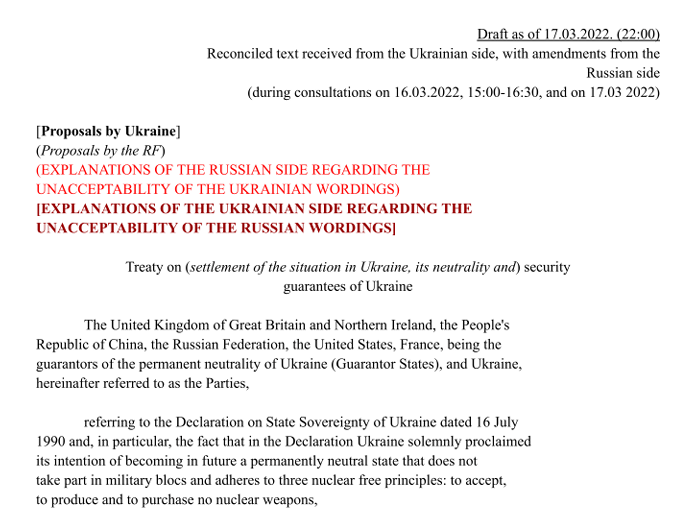
Source: https://static01.nyt.com/
Note that the US newspaper report is based on terms drafted between March 16 and 17, 2022, two weeks before the draft documents were initialed in Turkey. Subsequent reporting by the newspaper of the negotiations, which continued after the Istanbul meetings, concluded: “On April 15, five days after Mr. Abramovich told the Ukrainians about his meeting with Mr. Putin, the Russian negotiators sent a 17-page draft treaty to their president’s desk. Similar to the month-earlier version, the April 15 draft includes text in red highlighting issues in dispute. But such markings are almost entirely absent from the treaty’s first pages, where points of agreement emerged.”
In fact, Putin had been unable to convince Russian military and intelligence chiefs that the terms he had authorized for initialing would be enforceable and would not betray countrywide public support of the announced goals of the Special Military Operation.
Confirmation that Putin had been “micro-managing” the negotiations in Istanbul through Abramovich appears in the New York Times report of the process from Ukrainian and other sources. “ ‘Colleagues, I spoke to RA,’ Ukraine’s lead negotiator, Davyd Arakhamia, wrote on April 10 [2022] in a WhatsApp message to the Ukrainian team. ‘He spoke yesterday for an hour and a half with his boss.’ RA was Roman Abramovich, the Russian billionaire who played a behind-the-scenes role in the talks. His ‘boss,’ Mr. Putin, was urging the negotiators to concentrate on the key issues and work through them quickly, Mr. Arakhamia wrote. (A member of the WhatsApp group showed that message and others to reporters for The Times.).”
In the New York Times version, based on a March 17 draft of terms, no Russian source acknowledges the backlash Putin faced from the General Staff and the Security Council after the full extent of Abramovich’s role became clear from the terms Putin had told his negotiators to sign in Istanbul. After two weeks of internal debate, Putin was forced to back down, and the terms he and Abramovich had conceded on March 31 were revised. The Ukrainian sources feeding the New York Times reporters told them “we had no interest in continuing the talks.”
What is missing from this Ukrainian and American narrative, as well as from the public Russian versions, is that Putin retreated from the terms he had agreed with Abramovich. The role played by British Prime Minister Boris Johnson in the published narrative, repeated to the press by Israelis and others, had been a minor one.
Last Friday, Putin hinted that the General Staff has opposed his concession terms. “I haven’t spoken about this publicly either but some of those present here know about it. After the Russian army seized part of the Kherson and Zaporozhye regions, many Western politicians offered their mediation in a peaceful settlement of the conflict. One of them was on a working visit to Moscow on March 5, 2022. We accepted his mediation efforts, especially since he said during the conversation that he had secured the support of the leaders of Germany and France, as well as high-ranking US representatives.”
“In course of our conversation our foreign guest wondered – an interesting moment – saying if you are assisting Donbass, then why Russian troops are in the south of Ukraine, including in the Kherson and Zaporozhye regions? We responded to the effect that it was our General Staff ‘s decision [sic] on planning the operation. And I will add today that the idea was to bypass some fortified areas built in Donbass over the eight years by Ukrainian authorities, primarily for liberating Mariupol.”
“Then our foreign colleague specified – a professional man, to be fair to him: are Russian troops going to stay in the Kherson and Zaporozhye regions? And what will happen to these regions after the Special Military Operation has attained its goals? I answered to this that in general I do not rule out preservation of the Ukrainian sovereignty over these territories, provided Russia has a stable land bridge to Crimea.”
It had been clear to the president then, and it is clearer now, that Putin’s “stable land bridge to Crimea” was politically incompatible with “Ukrainian sovereignty” because, as the General Staff kept repeating to Putin, it was militarily impossible.
On Friday Putin kept the identity of the mediator secret on Friday. But it is already well known from the mediator himself. It was the Israeli, former prime minister Naftali Bennett. He has confirmed his meeting in Moscow with Putin on March 5, 2022. For Putin to authorize Abramovich and Bennett, two Jewish Israelis, to negotiate Russia’s end-of-war war terms with the Kiev regime remains a highly sensitive issue in Moscow.
Russian public opinion has been clearer on the end-of-war objectives and on terms of negotiations than Putin has admitted himself to have been. For the poll evidence, click to read.

Source: https://johnhelmer.net/
What now, what next?
According to the President on Friday, “a verbatim return to the security proposals that we put forward twenty-five, fifteen, or even two years ago is impossible, as too much has happened and the conditions have changed. However, the basic principles and, most importantly, the very subject of dialogue remain unchanged.” From Putin’s new statement of end-of-war terms, he says the “parameters were broadly agreed upon during the Istanbul negotiations in 2022, including specific details on demilitarisation such as the agreed numbers of tanks and other military equipment. We reached consensus on all points.”
Now, however, with the new long-range artillery, drones, missiles, and F-16s supplied by NATO to the Kiev regime, the depth of “demilitarisation” is more than ten times beyond the “25 mile” (40 kiliometre) range which was one of the Russian parameters in the Istanbul agreement drafts of March 2022. Read the backfile on what Putin has been calling this “sanitary zone”.
Denazification, the second strategic goal of the Special Military Operation, means regime change in Kiev, but Putin implied last Friday that he means no more than the replacement of Vladimir Zelensky because “the presidential term of the previously elected head of Ukraine has expired along with his legitimacy, which cannot be reinstated by any tricks”. That, he added, leaves only one constitutional authority in the country: “unlike the executive branch, the Verkhovnaya Rada is a legitimate body now. Ukraine is not a presidential republic, but a parliamentary and presidential republic. This is the point.”
Russian sources believe this is beside the point. As Rozhin has written, “the goals of the SVO will be achieved by military means.”
Asked to list what they believe will now be the military targets in the General Staff’s strategy, the emphasis, the sources say, will continue to be energy generation plants and distribution hubs and networks, especially those through which the replacement electricity is entering the Ukraine from its neighbours – the Chervonograd substation (from Poland); the Mukacheve substation (Slovakia, Hungary, Romania); the Usatove and Primorska substations (Moldova, Romania); and the Khmelnitsky, Dobrotvirka and Pivendennoukrainska generating hubs. .
GERMAN MAP OF THE UKRAINE’S ELECTRICITY IMPORT LINES AS OF OCTOBER 2021
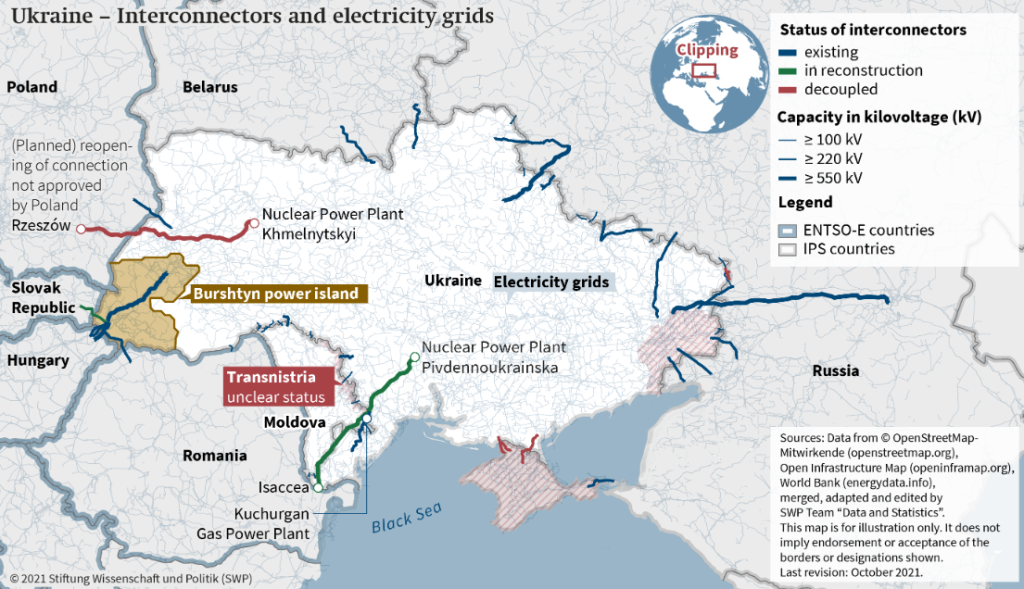
Source: https://www.swp-berlin.org/
UKRAINIAN MAP OF THE IMPORT LINE CAPACITIES AS OF OCTOBER 2023
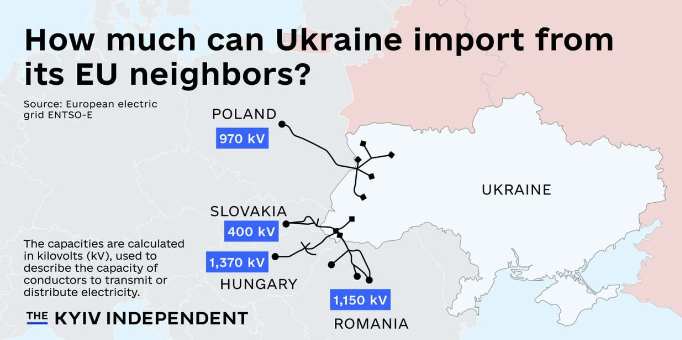
Source: https://kyivindependent.com/
The total capacity of these electricity lines is shown as just under 3,890 kV. On June 10, the Ukrainian state utility Ukrenergo reported that “almost 25,000 MWh of electricity were imported into the country from Romania, Slovakia, Poland, Hungary, and Moldova during the day”. A NATO military engineer estimates that although Russian raids have forced some of the lines into what is reported publicly as maintenance, the import volume is still running “at or near capacity. But they are struggling. Watch for renewed attacks on the substations connecting the Ukrainian grid to Poland and Romania.” For more technical details on the situation from US engineers, read the comments here.
“If these are knocked out,” a NATO military engineer says, “it’s all over.”
In the meantime, according to this Spanish newspaper report, the billed charge for electricity is rising so fast and so high, at least a quarter of the Ukrainian population cannot afford it. “The electricity tariff from June has increased by 64%, from 2.64 hryvnas per kilowatt-hour (kWh) to 4.32 hryvnas (between $0.064 and $0.11). Days before the Ukrainian Cabinet met on May 30, it was leaked that the increase would be 80%. But the reaction in the media and on social networks made it clear that the measure was highly unpopular at a time when the authorities must also deal with enormous unease over the compulsory conscription process to incorporate hundreds of thousands of civilians into the army.”
“Dixi informs this newspaper that its estimates in 2023 indicated the average monthly consumption per household in Ukraine was 155Kwh. In this average scenario, the monthly household bill would rise from $10 to $16.6. The Ukrainian Statistics Service indicates that the average monthly salary in Ukraine was equivalent to $471 at the end of last year. The World Bank estimated that in 2022 alone, the year in which Russia launched its invasion, the poverty rate in Ukraine rose from 5.5% to 24% of the population. There is no alternative to raising tariffs, say the government and companies in the sector.”
This means that the multi-billion dollar cash transfers to the Kiev regime from the US and European Union for non-military budget support are being diverted, and failing to reach the population.
To run emergency generating sets powered by diesel and to fuel the Ukrainian military movements requires fuel storages. The Russian Defense Ministry’s daily operations bulletin is reporting daily strikes at these throughout the country.
On the border there are a series of targets which Russian sources expect to be hit in the coming days. The lead image map shows their locations and functions (red for rail, orange for road, blue for bridge and ferry). Rozhin has reprinted this analysis of these targets. “Since sending military aid by air is not available, most of the cargo is delivered by rail, heavy trucks, or, much more risky, by sea. Either way, all cargoes go through customs and checkpoints. In the west and south-west of Ukraine there are about 87 sea, pedestrian, rail, and road border crossings…Taking into account the checkpoints that Ukraine received from the USSR, this number can be increased by almost half, but a significant part of such crossings is either destroyed, looted in previous decades, or abandoned under the USSR. However, most of the border crossings are on the border with Moldova. There are 34 of them, but they are not used as intensively as the checkpoints for transit to and from the territory of NATO countries. The state of some of them is far from ideal.”
Rozhin’s purpose in mapping the targets is to ask the question publicly: “If all border crossings are known, why not intercept military cargo there?”
“In the west and south-west, Ukraine borders Poland, Slovakia, Hungary, Romania and Moldova. The total length of the border in these areas is 777 km. The long-range weapons of the Russian Federation — for example, X-101 missiles with cluster and high-explosive warheads — are sufficient to destroy military cargo directly on the border. All the coordinates of the border crossings are almost certainly known to the Russian military. But the main problem in the matter of the destruction of military cargo at these points is reconnaissance and obtaining reliable data on the time of shipments of cargo columns. The determining parameter in this case is the precise time for the crossing of the cargo on to the territory of Ukraine.” The original military blog source can be followed here.
In similar fashion, Rozhin and other military bloggers are asking publicly why there are Kremlin restrictions on targets which the US, NATO and the Ukrainians are using for drone and missile attacks on Crimea, as well as deeper into the Russian heartland. Putin addressed this question in his press conference with international reporters on June 5.
“What can the Ukrainian military – not the ones who are just sitting there and pressing buttons – but the higher-ranking ones do when it comes to target assignment? They can identify a target that is a priority for them. But they are not the ones who decide whether a particular target should be hit, because, to reiterate, a WTA (weapon target assignment) is formed and effectively entered only by those who supply the weapons. If we are talking about ATACMS, then the Pentagon is doing it. If it is Storm Shadow, then the British are. It is even more straightforward in the case of Storm Shadow, because the target assignment is entered automatically, without the involvement of the military personnel on the ground. The British do it, that is all there is to it.”
“And when the Bundeswehr military were pondering an attack on the Crimean Bridge or other targets, they were thinking for themselves. No one was doing it for them, right? They were going to do it. The same goes for the French specialists. Western specialists do it. We have no illusions about this. How are we supposed to respond?”
“First, we will, of course, improve our air defence systems. We will be destroying their missiles. Second, we believe that if someone is thinking that it is possible to supply such weapons to a war zone in order to deliver strikes at our territory and to create problems for us, why can we not supply our weapons of the same class to those regions around the world where they will target sensitive facilities of the countries that are doing this to Russia? The response could be symmetrical. We will give it a thought.”
“Third, sure enough, such actions will wreck international relations, which have already hit rock bottom, and undermine international security. Ultimately, if we see that these countries are being embroiled into a war against us, and this constitutes their direct involvement in the war against the Russian Federation, we reserve the right to respond in kind. Generally speaking, this path may lead to serious problems. I think that covers it all. If you have any leading questions, please go ahead. But I do not think I can add anything to what I just said.”
Several days later, after a fresh series of missile attacks on Crimea were launched, the Russian military bloggers responded with this leading question – why are the US, French and British systems operating in the Black Sea not targeted when their role in the Russian attacks is certain?
Mikhail Zvinchuk, principal of the Rybar military blog, has reported that on the eve of the June 10-11 missile attacks on the Peninsula, “it is worth noting that… NATO satellites were again active. The target reconnaissance alternately depended on which areas were planned [for missile attack] — on June 8-9, the northwestern part of the Crimea was filmed, and on June 10 and 11, Sevastopol and the centre of the Peninsula. In addition, yesterday and the day before yesterday, special attention of the satellites was paid to the eastern part of the Crimea. Filming was conducted of Theodossia, Kirovsky, Kerch, and of course, the Crimean Bridge… Also, during today’s attack [June 12] in the western part of the Black Sea, the American RQ-4B drone was operating…After the strikes, it moved to the eastern part of the sea area closer to the Crimean Bridge, where, unhindered, it was operating until the morning. This fact, together with the active work of the satellites, as well as consecutive strikes on the air defence positions, first in the northwest, then in the south, allow us to conclude that the next goal may be the east of the Peninsula.”
ITALIAN MAP OF US AIR FORCE DRONE OPERATIONS AGAINST CRIMEAN TARGETS
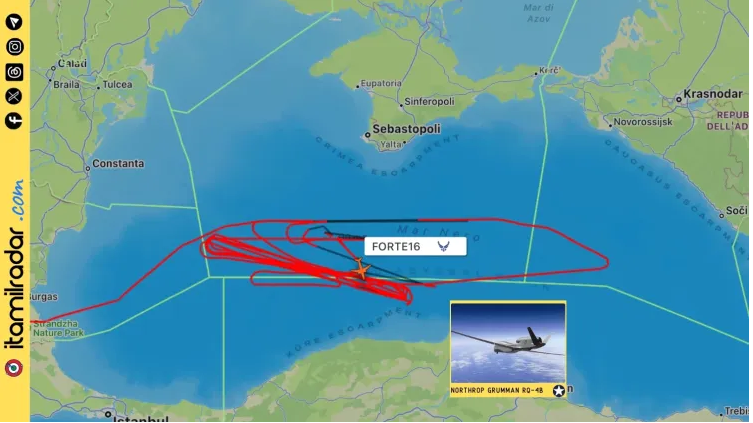
Source: https://www.itamilradar.com/-- the map indicates the tracking paths of the RQ-4B on May 29. This Italian source regularly maps and reports on US and NATO operations in the Black Sea region, usually with a time lag of several days.
In parallel, according to the Rybar report, there appeared “for the first time in a month and a half, south of Feodosia, the French long-range radar detection aircraft, the E-3F, and the French Navy aircraft [Bréguet] Atlantique 2 [based at Souday Bay, Crete]. In the west of the sea also flew the RC-135V of the British Air Force. That is a lot for one day, isn’t it? As noted repeatedly, the main goal of the West is the Crimean Bridge, and for this it is necessary to reduce the combat potential of the air defence in the Crimea.”
The Russian Air Force has downed a USAF drone operating against the Crimea in March 2023. Since last October the Houthis, assisted by Iran and possibly by Russia, have downed several USAF drones operating in the Red Sea to assist Anglo-American attacks on targets in Yemen.
What the military bloggers like Rozhin and Zvinchuk are saying is why not strike at these targets now?
“What we have in the end,” Zvinchuk has written on June 12, is that “the air defence strikes are aimed at weakening the protection near the Crimean Bridge, which must be taken into account and measures taken to modify the available means of missile defence – the missiles are shot down, but not all of them. The enemy is clearly preparing for a new attack. We’ve already identified two false starts – they can be called the harbinger of massive strikes; it is possible they will be aimed at the bridge. In the future, the lack of opposition, the reluctance to accept reality and learn from mistakes can affect the potential of the air defence of the Crimea. Already this will play a key role when the F-16 fighters will make their appearance.”
“Reluctance to accept reality and learn from mistakes” – this criticism is aimed, not at the General Staff, but at the Kremlin.
MAP OF UKRAINE MISSILE STRIKES AT CRIMEA, JUNE 10-12
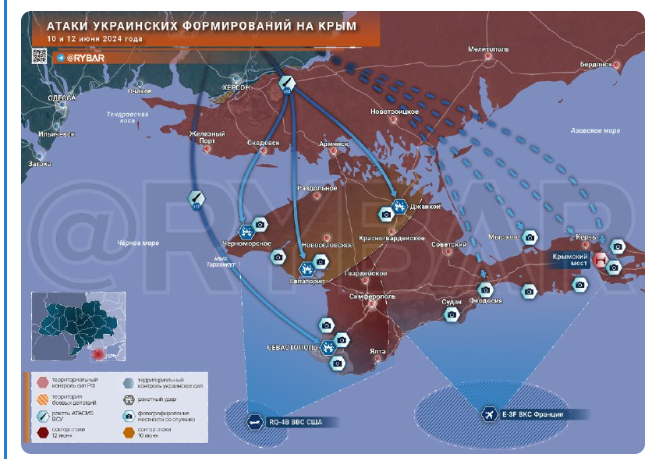
Map of Ukrainian missile strikes on Crimea, June 10-12 – posted by Rybar, June 21 at 20:29h.
On June 14 Zvinchuk returned to the targeting of the USAF drones. “For the first time, the American Triton [MQ-4C] appeared on the Crimean shores right before a massed blow on the Crimea. The question of what you can expect from its presence in the Black Sea region begs itself. Especially when the curators of the Ukrainian military will not miss such an opportunity to attack. And if this happens, it will again be possible to raise the question of the advisability of a more radical counteraction to American aviation near the Russian borders. Someday, maybe, we will come to the same measures as the Houthis.”


